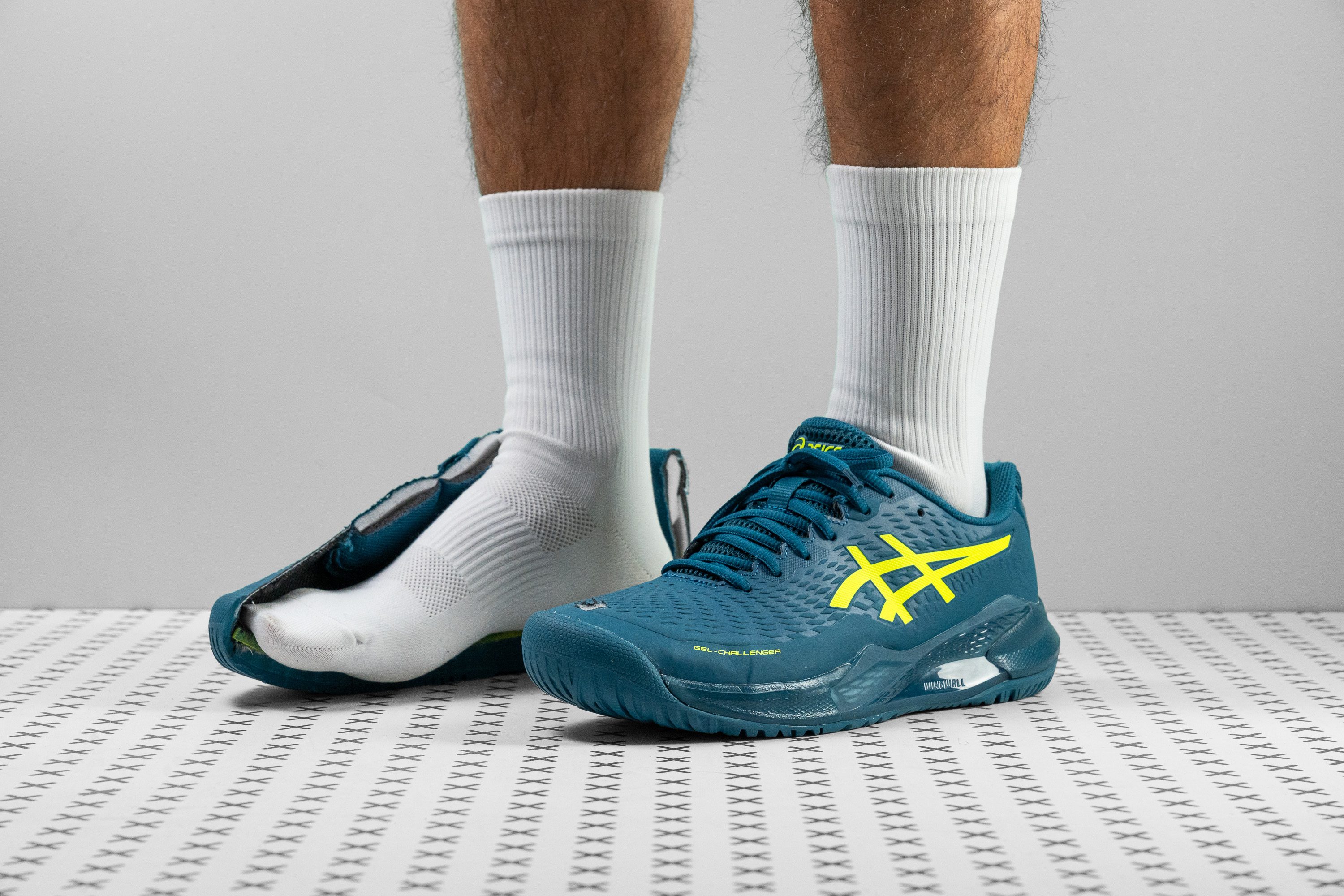Our verdict
- Top pick in best ASICS tennis shoes (2024)
Pros
- Excellent stability and arch support
- Super hard-wearing outsole
- Grip of a more expensive tennis shoe
- Light for a stability-oriented shoe
- Reliable impact protection
- Plush and cushy in-shoe feel
- More flexible than average
Cons
- Lacks breathability
- Upper is not so abrasion-resistant
Audience verdict
Comparison
The most similar tennis shoes compared
+ + Add a shoe | |||||
|---|---|---|---|---|---|
| Audience score | 80 Good! | 78 Good! | 83 Good! | 91 Superb! | |
| Price | £105 | £65 | £110 | £135 | |
| Shoe type | All CourtHard Court | All CourtHard Court | Hard Court | All CourtHard Court | |
| Shock absorption | Moderate | Low | Low | Low | |
| Energy return | Low | Moderate | Moderate | Low | |
| Traction | Moderate | High | Low | Moderate | |
| Construction | Stability | Stability | Stability | Stability | |
| Breathability | Moderate | Breathable | Moderate | Moderate | |
| Weight lab | 12.5 oz / 354g | 11.3 oz / 319g | 13.9 oz / 395g | 13.9 oz / 393g | |
| Lightweight | ✗ | ✓ | ✗ | ✗ | |
| Drop lab | 9.6 mm | 10.2 mm | 9.0 mm | 10.9 mm | |
| Width / fit | Medium | Medium | Wide | Medium | |
| Toebox width | Medium | Medium | Medium | Narrow | |
| Size | True to size | Slightly small | - | True to size | |
| Midsole softness | Firm | Balanced | Firm | Firm | |
| Stiffness | Moderate | Flexible | Moderate | Moderate | |
| Torsional rigidity | Stiff | Moderate | Stiff | Stiff | |
| Heel counter stiffness | Moderate | Flexible | Stiff | Stiff | |
| Midsole width - forefoot | Average | Narrow | Wide | Average | |
| Midsole width - heel | Average | Narrow | Wide | Average | |
| Outsole durability | Good | Decent | Good | Good | |
| Heel padding durability | Bad | Bad | Good | Bad | |
| Heel stack lab | 30.4 mm | 28.6 mm | 28.5 mm | 32.5 mm | |
| Forefoot | 20.8 mm | 18.4 mm | 19.5 mm | 21.6 mm | |
| Insole thickness | Average | Average | Average | Average | |
| Removable insole | ✓ | ✓ | ✓ | ✓ | |
| Heel tab | None | None | None | None | |
| Toebox durability | Decent | Bad | Good | Good | |
| Outsole hardness | Average | Average | - | Average | |
| Outsole thickness | Average | Average | Average | Average | |
| Ranking | #36 Bottom 25% | #33 Bottom 15% | #25 Bottom 35% | #3 Top 8% | |
| Popularity | #28 Bottom 41% | #14 Top 36% | #19 Top 49% | #1 Top 3% |
Who should buy
We cannot think of a better shoe than the ASICS Gel Challenger 14 if:
- you are a beginner/occasional tennis player
- you need a high level of support and stability
- you want a budget-friendly shoe that doesn't skimp on outsole durability
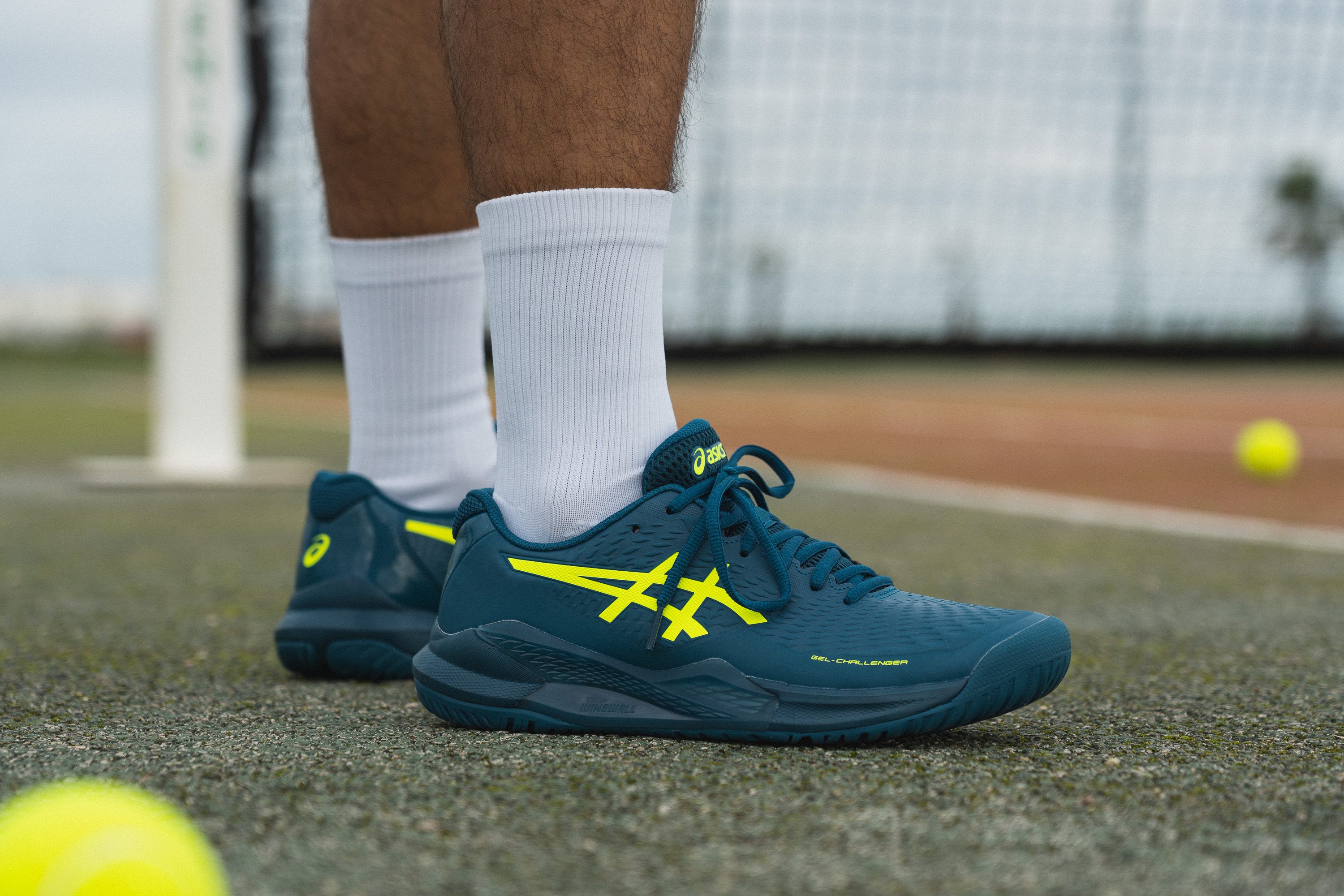
Who should NOT buy
If you are a toe dragger through and through, the Challenger 14 most likely won't last long enough for you. While it looks tough, the shoe's synthetic upper lacks the abrasion resistance we've seen in shoes like the ASICS Gel Resolution 9 and the ASICS Court FF 3.
Another reason to look elsewhere is if you value breathability in your tennis footwear. We recommend looking into the ASICS Solution Speed FF 2 if you seek better ventilation.

Cushioning
Shock absorption
The Challenger 14 is a safe option for beginners and players who prefer balanced and well-rounded cushioning.
Our lab tests confirmed that this ASICS shoe has a decent amount of shock absorption to keep the foot protected from repetitive impact (95 SA in the heel and 69 SA in the forefoot). However, it's not too cushioned to compromise court feel or make you feel disconnected.
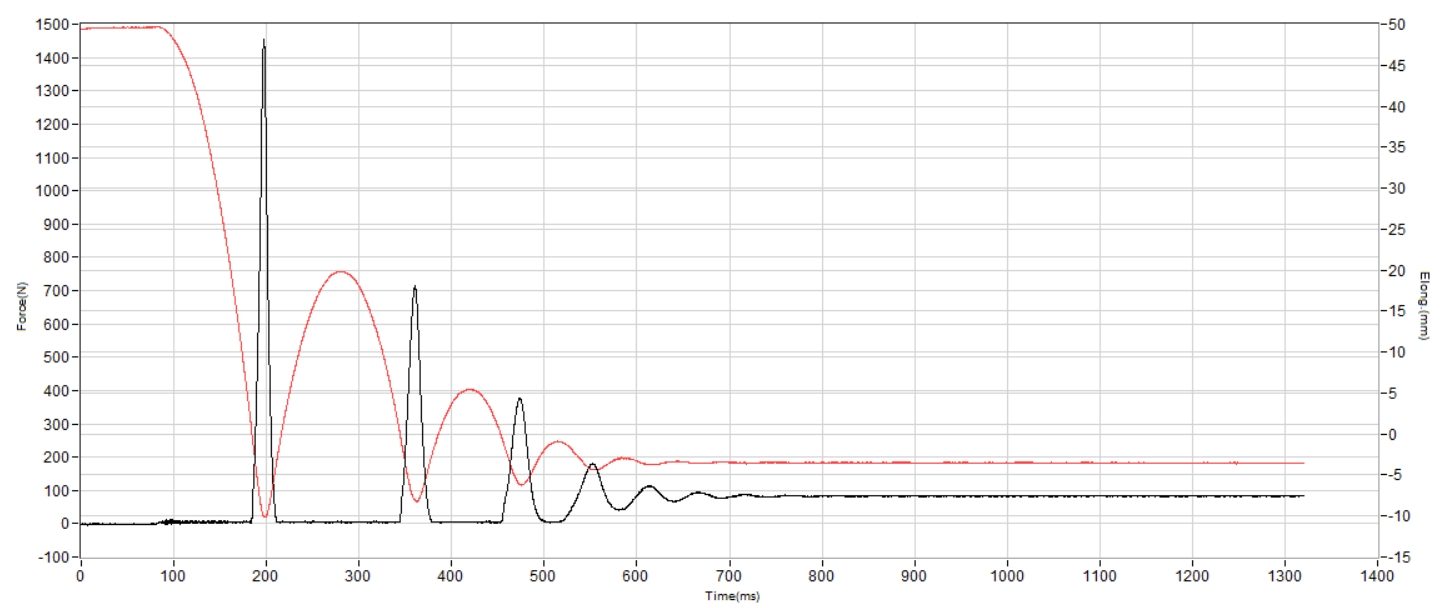
| Asics Gel Challenger 14 | 95 SA |
| Average | 99 SA |
Energy return
The nimble and grounded nature of this ASICS shoe also shows up in its moderate energy return.
Measuring the latter at only 44.7% in the heel and 46.8% in the forefoot, there is not much rebound to expect from the Challenger 14.
| Asics Gel Challenger 14 | 44.7% |
| Average | 48.8% |
Heel stack
Measuring the shoe's heel stack, we got 30.4 mm, which is on par with the category average.
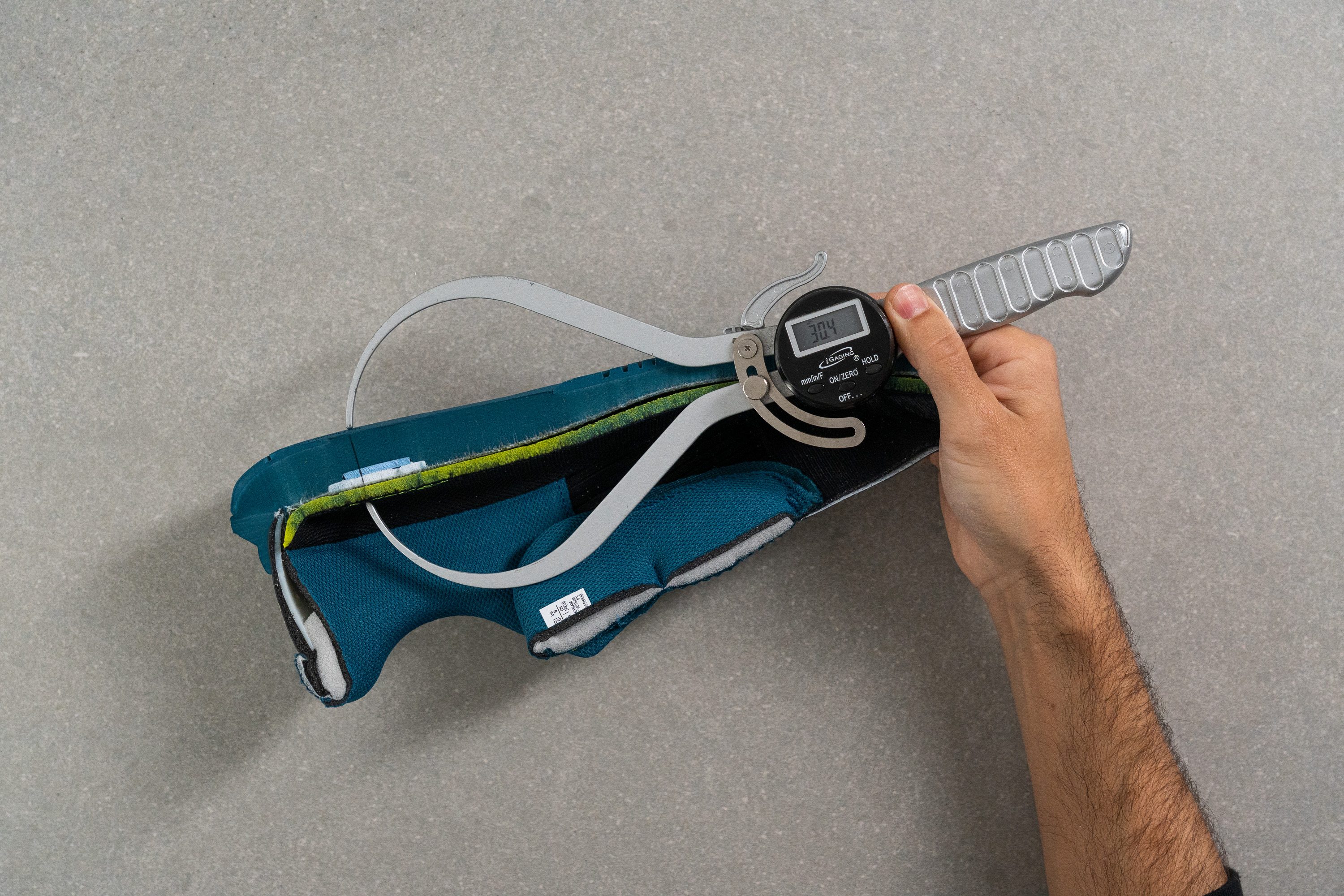
| Asics Gel Challenger 14 | 30.4 mm |
| Average | 29.2 mm |
Forefoot stack
With a calliper measurement of 20.8 mm, there is also a good amount of forefoot cushioning in the Challenger 14.
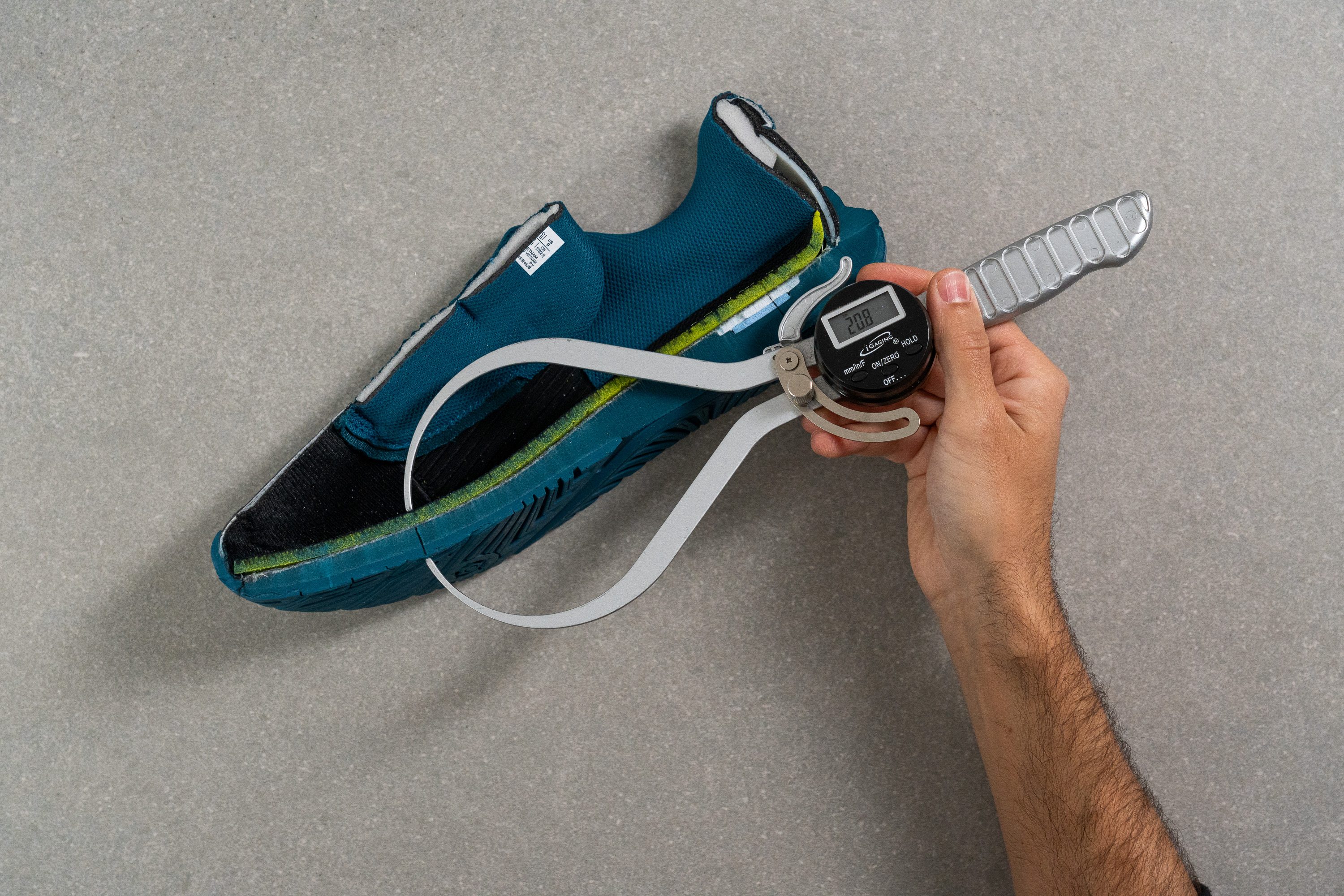
| Asics Gel Challenger 14 | 20.8 mm |
| Average | 19.5 mm |
Drop
But we should note that this ASICS shoe doesn't feel detached from the ground either. It has a moderately steep incline between the heel and the toes. At 9.6 mm, it makes the heel only slightly elevated allowing for a cushioned yet stable experience.
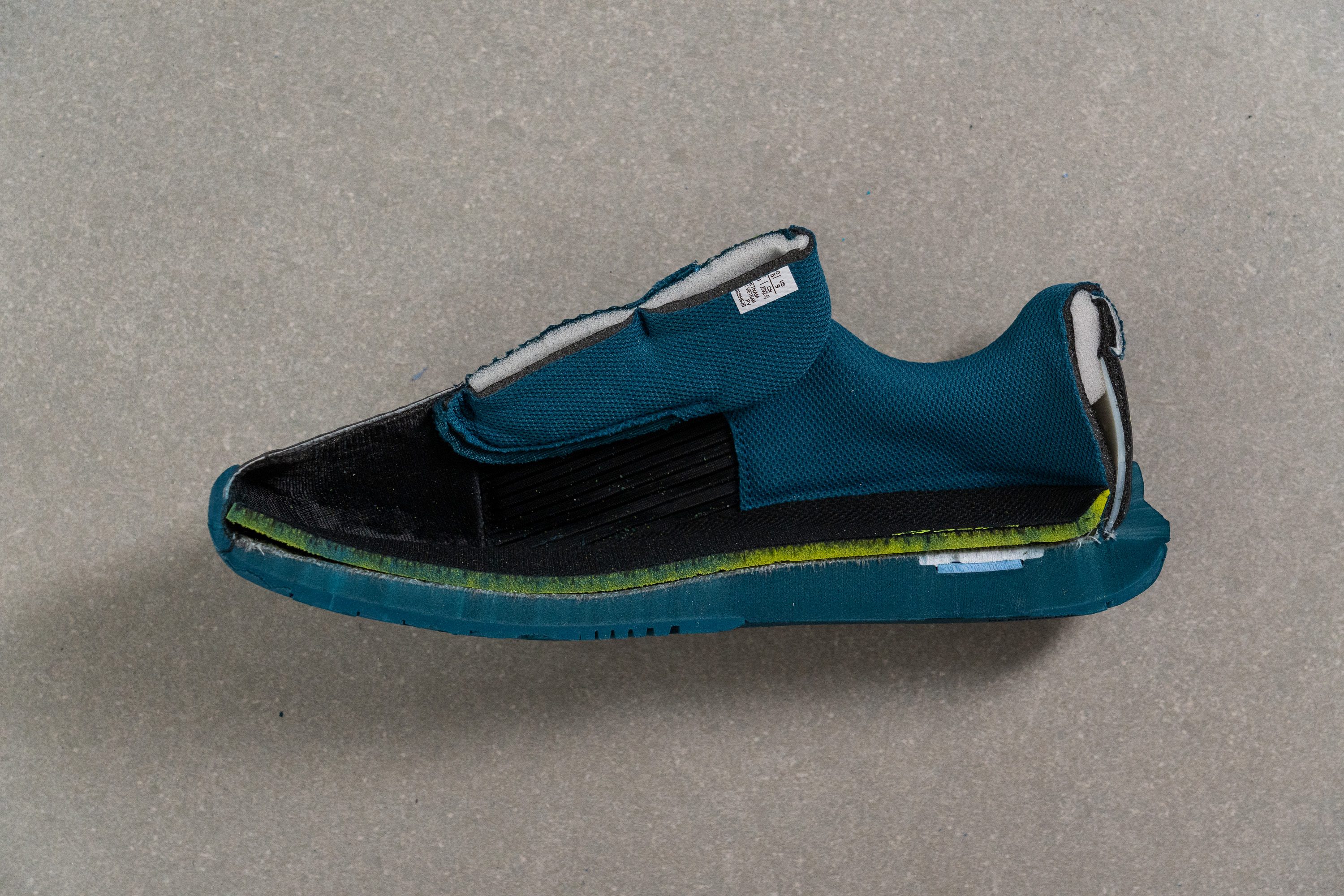
| Asics Gel Challenger 14 | 9.6 mm |
| Average | 9.7 mm |
Midsole softness
A major portion of the shoe's midsole is made of a single-density foam. ASICS doesn't specify what kind of foam that is but we measured its softness at 31.3 HA. That's a moderately firm compound which is typical for tennis shoes.
Under the heel, the Challenger 14 features a rearfoot GEL unit. Wonderfully squishy, it balances out the firmer carrier foam by adding a bit of bounce.
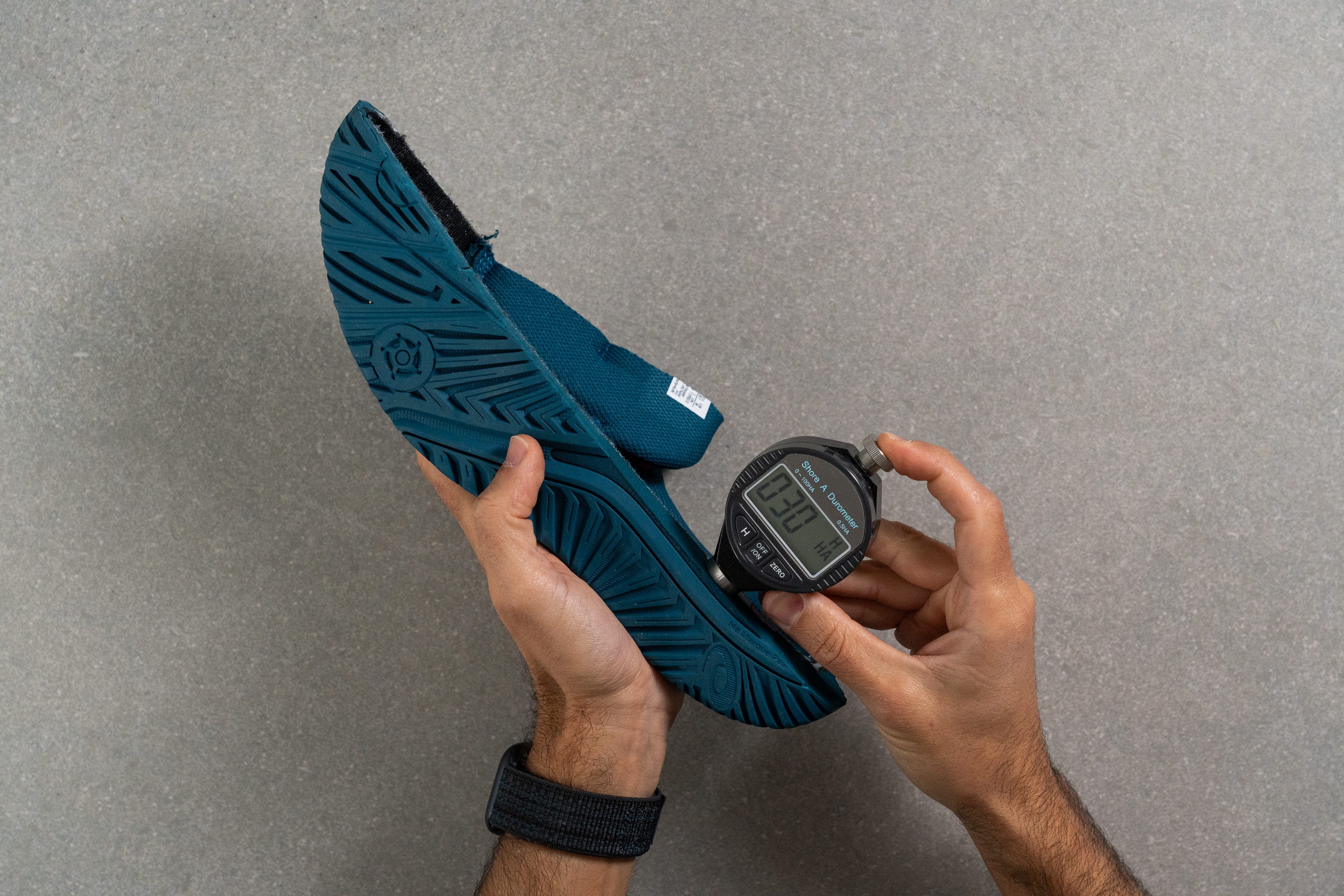
| Asics Gel Challenger 14 | 31.3 HA |
| Average | 28.1 HA |
Size and fit
Size
Asics Gel Challenger 14 fits true to size (41 votes).
Width / Fit
The fit of the ASICS Gel Challenger 14 can be described as perfectly medium. Having medium-width feet ourselves, we felt like the shoe was fine-tuned to our foot shape.
Our subjective experience was also confirmed by the calliper measurements we took using the shoe's gel mould. In the widest part (between the big toe and the pinkie), the tool returned 93.7 mm. It is slightly wider than the tennis shoe average but still within the D medium range. Just a touch of extra wiggle room.
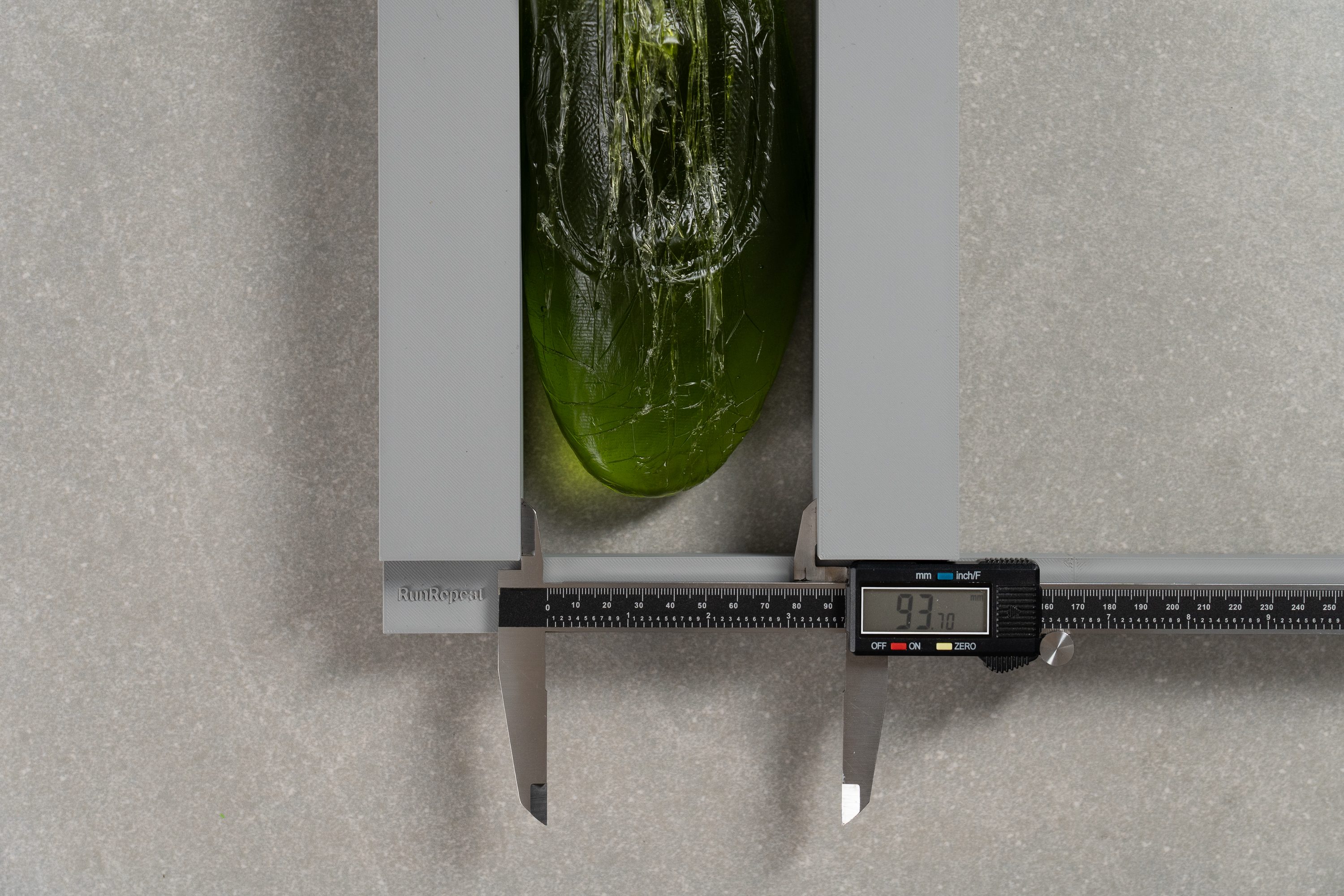
| Asics Gel Challenger 14 | 93.7 mm |
| Average | 92.9 mm |
Toebox width
There is no drastic tapering towards the toes either. At the big toe mark, we measured the upper's width at 67.5 mm. Slightly narrower than average but not restricting on the toes.
However, if you are someone with wide feet, you will wish for more in-shoe space in the Challenger 14. In that case, we recommend looking into tennis shoes from New Balance as they have roomier toeboxes and are often available in multiple width options.

| Asics Gel Challenger 14 | 67.5 mm |
| Average | 69.2 mm |
Toebox height
The toebox height of this ASICS shoe brings no surprises as it comes in at a standard 24.2 mm.

| Asics Gel Challenger 14 | 24.2 mm |
| Average | 25.1 mm |
Traction / Grip
What's amazing about the Challenger 14 is that you get to enjoy the highest quality of grip but for £50 less! We found that the traction pattern on this ASICS shoe is 100% identical to that of the Gel Resolution 9!
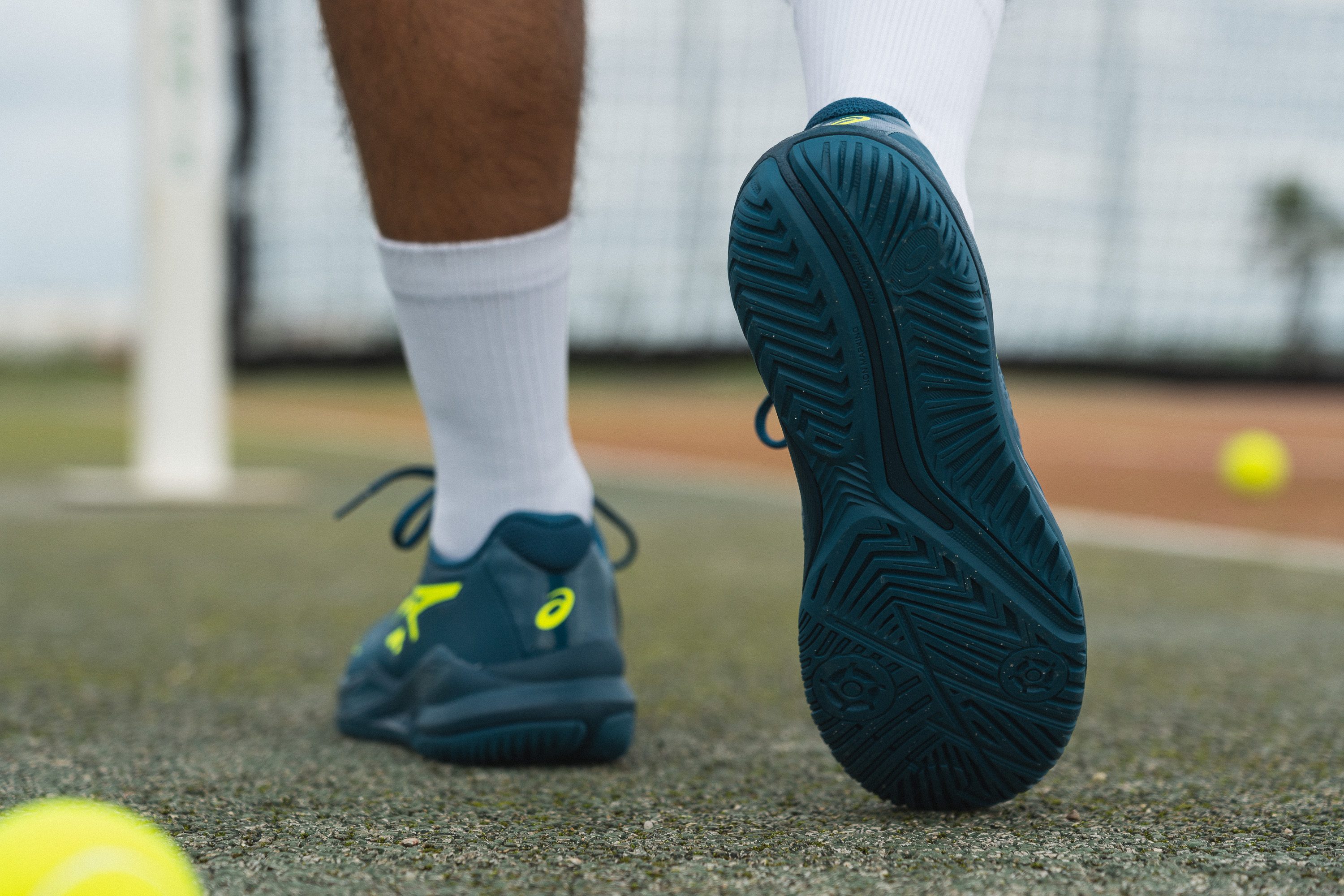
The shoe's outsole offered a fantastic balance of grip and give, providing great stopping power when we needed it but letting us slide around the court just as freely.
Forefoot traction
What's amazing about the Challenger 14 is that you get to enjoy the highest quality of grip, but for £50 less!
Not only is the traction pattern of this ASICS shoe 100% identical to that of the Gel Resolution 9, but it also showed the exact same friction score in our grip test! Measuring how much traction the Challenger 14 generates against concrete, we recorded a solid reading of 0.76.
The shoe's outsole offered a fantastic balance of grip and give, providing great stopping power when we needed it but letting us slide around the court just as freely.
| Asics Gel Challenger 14 | 0.76 |
| Average | 0.76 |
Outsole design
The Challenger 14 features separated traction zones to accommodate manoeuvrability and more controlled footwork. It has thick and deep herringbone treadlines and two pivot points for a mix of grip and give.

Flexibility / Stiffness
The Challenger's DYNAWALL support ends near the forefoot, creating a good breaking point for the foot to bend at the metatarsal joints. However, we found that it doesn't really make this ASICS shoe more pliable than average.
According to our shoe flexing tester, the Gel Challenger 14 requires a standard amount of force (16.6N) to bend by 30 degrees. This is on par with the category average which is not surprising given the shoe's thicker forefoot stack and stiff stabilising components.
This is good news for those who prefer more rigid shoes for their supportive experience and forefoot snappiness.
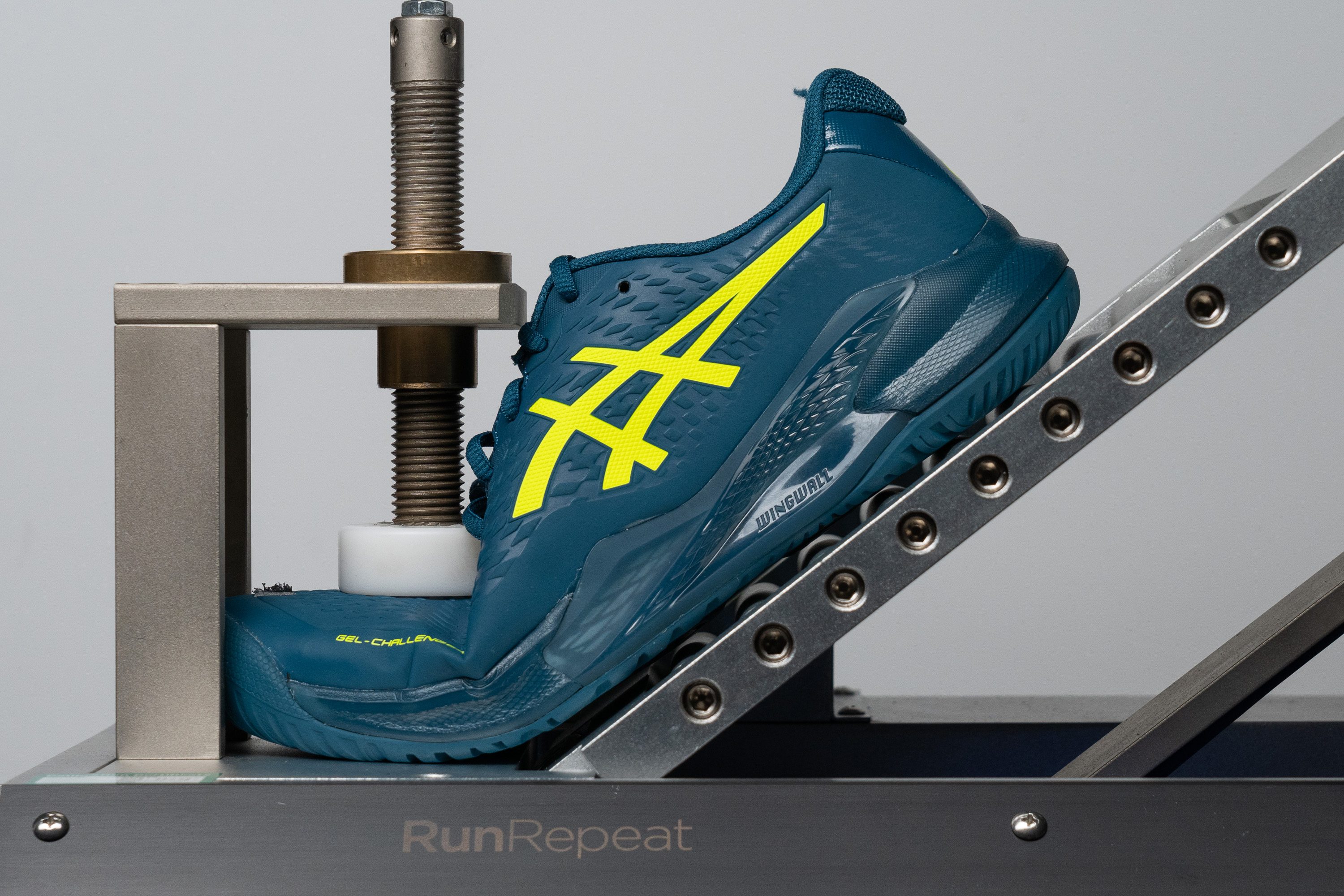
| Asics Gel Challenger 14 | 16.6N |
| Average | 16.6N |
Weight
The DYNAWING setup on the sides of the ASICS Gel Challenger 14 makes the shoe seem heavier than it is. We felt quite nimble moving all over the court in this tennis shoe.
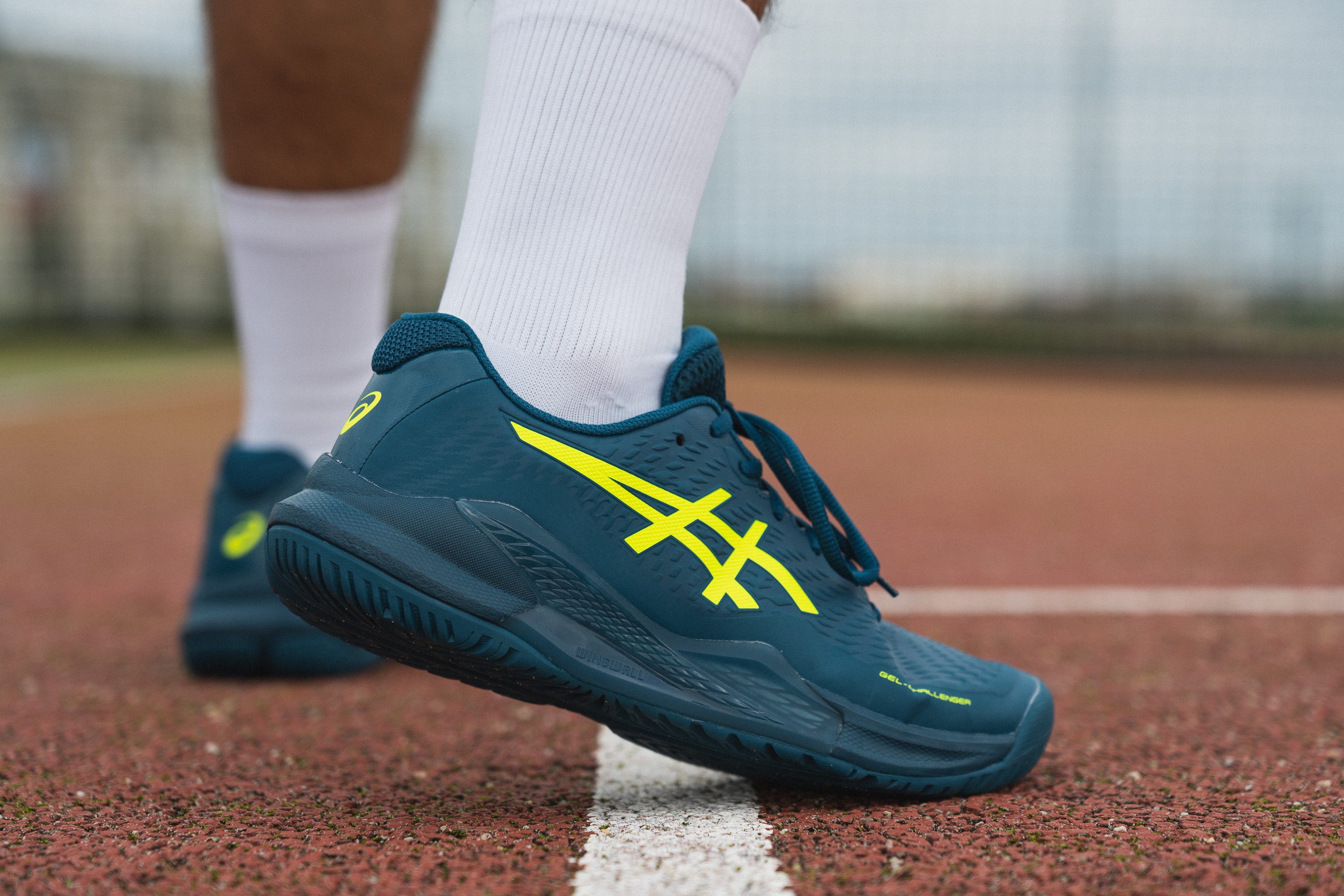
Placing it on the scale, we got 12.5 oz (354g) in a men's US size 9. That's even lighter than average! Especially for a shoe with such pronounced stability features.
For context, ASICS' step-up stability shoe (Gel Resolution 9) comes in at 13.8 oz (392g).
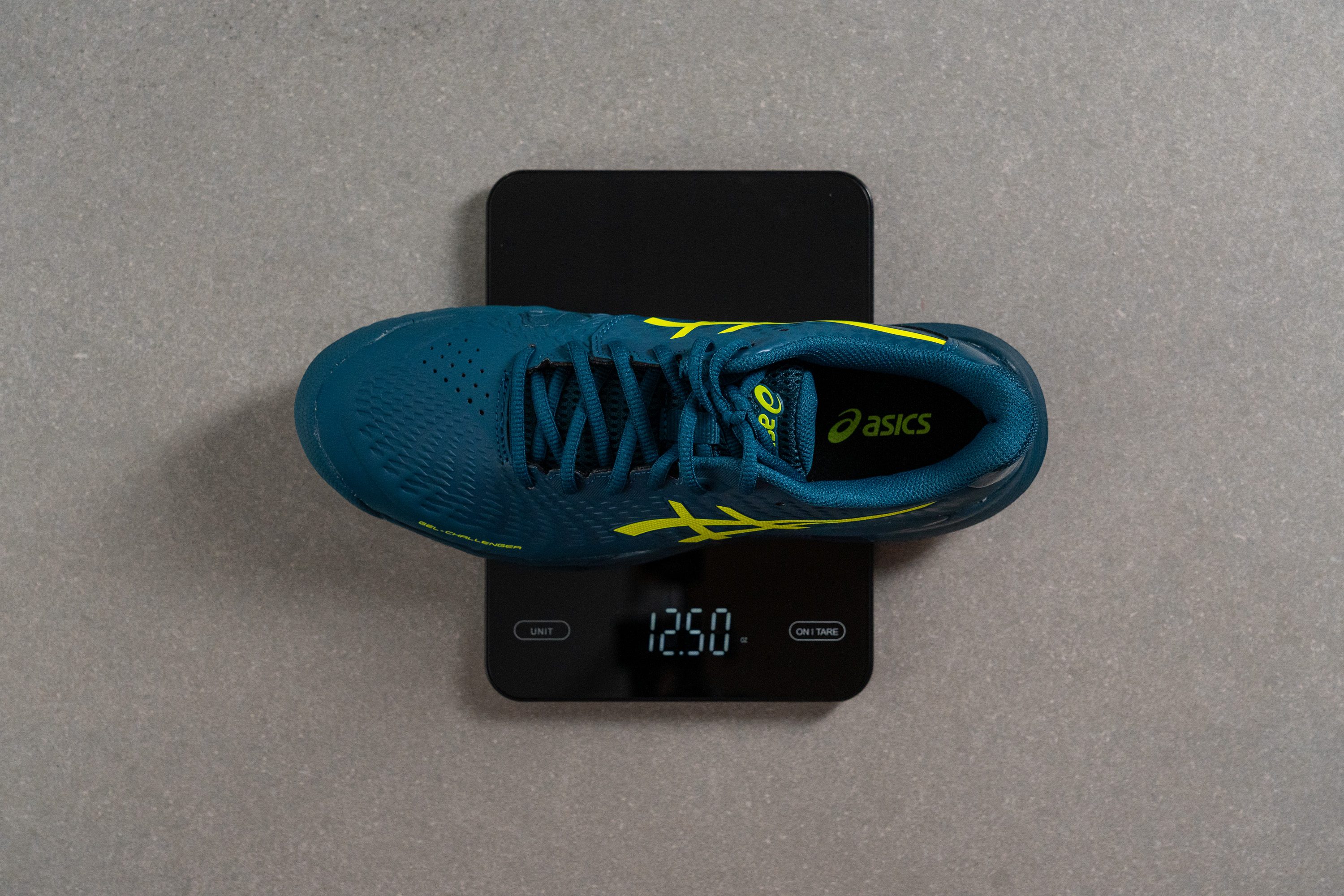
| Asics Gel Challenger 14 | 12.5 oz (354g) |
| Average | 12.8 oz (362g) |
Breathability
Let's be clear, the Challenger 14's synthetic upper is one of the thickest we've seen on a tennis shoe! So, ventilation is only allowed through the mesh tongue and a few perforations on the toebox.
This is easily illustrated in our proprietary breathability test. Filling the shoe's upper with smoke, we can see how none of it escapes through the toebox but finds a way through the tongue.
ASICS Solution Speed FF 2 (on the right) proved to be much better ventilated
This is the reason why we lowered the shoe's breathability score to only 3 out of 5. But the good news is that very few tennis shoes get more than 3 due to reinforced uppers.
Even when we hovered the shoe's half-cut upper over the light, we couldn't see a single pore. The material is dense throughout.
The light didn't even shine through those ventilation holes in the toebox! Looking at them up close through our microscope revealed that there is a tightly woven mesh layer underneath. It also stands in the way of letting the air escape so freely.
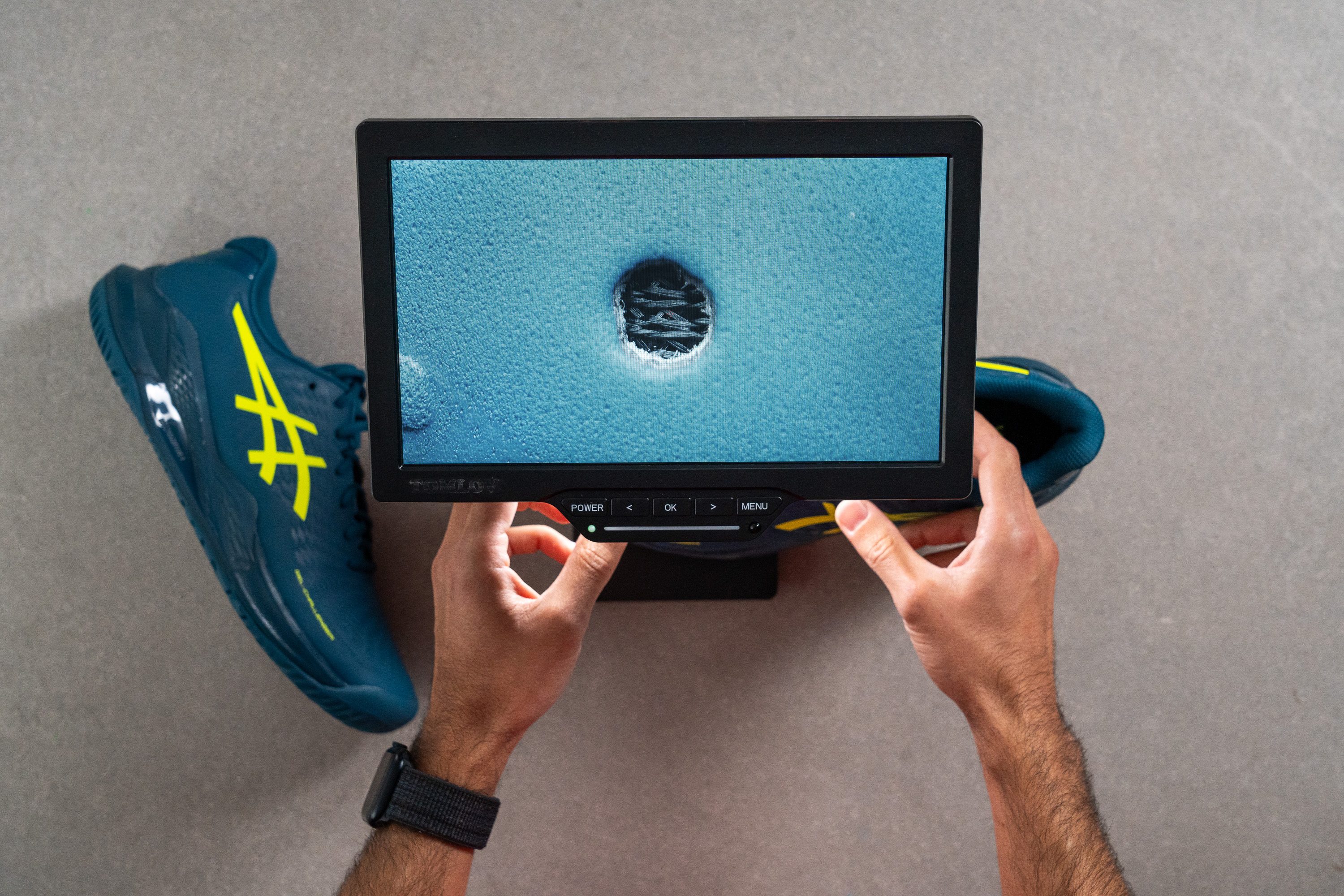
| Asics Gel Challenger 14 | 3 |
| Average | 3.2 |
Stability
Lateral stability test
The DYNAWING stability system has a slightly different configuration in the ASICS Gel Challenger 14 than in the brand's top stability shoe, the Gel Resolution 9. But it still proved to be effective in our forceful lateral movements and crossover steps.
The shoe allowed us to forget about potential ankle rolls and focus on the game wholeheartedly.
Even though the Resolution 9 has more rearfoot reinforcement, you can see how both ASICS shoes are taking good care of the arch and ankle support.
Torsional rigidity
The brand's DYNAWALL system creates such a strong midfoot hold that we couldn't even twist it one bit! The video below shows our struggles.
Based on this manual test, we rated the shoe's torsional rigidity with the highest possible score - 5 out of 5. It is the same level of stiffness as we observed in the Resolution 9.
| Asics Gel Challenger 14 | 5 |
| Average | 4.4 |
Heel counter stiffness
The Gel Challenger 14 also made sure that there was enough stiffness and structure in its heel counter. Playing in this ASICS shoe, we never got a hint of heel slippage or undue ankle play.
Assessing its stiffness on a 1-5 scale, we gave it nearly the highest - 4 out of 5.
| Asics Gel Challenger 14 | 4 |
| Average | 4.1 |
Midsole width - forefoot
Interestingly enough, the ASICS Gel Challenger 14 managed to achieve a very high level of stability without going for a super wide platform.
Measuring the widest part of the forefoot, we got 110.6 mm on our calliper. That's no different from the average across tennis shoes. The lateral outrigger is quite supple in this ASICS shoe.
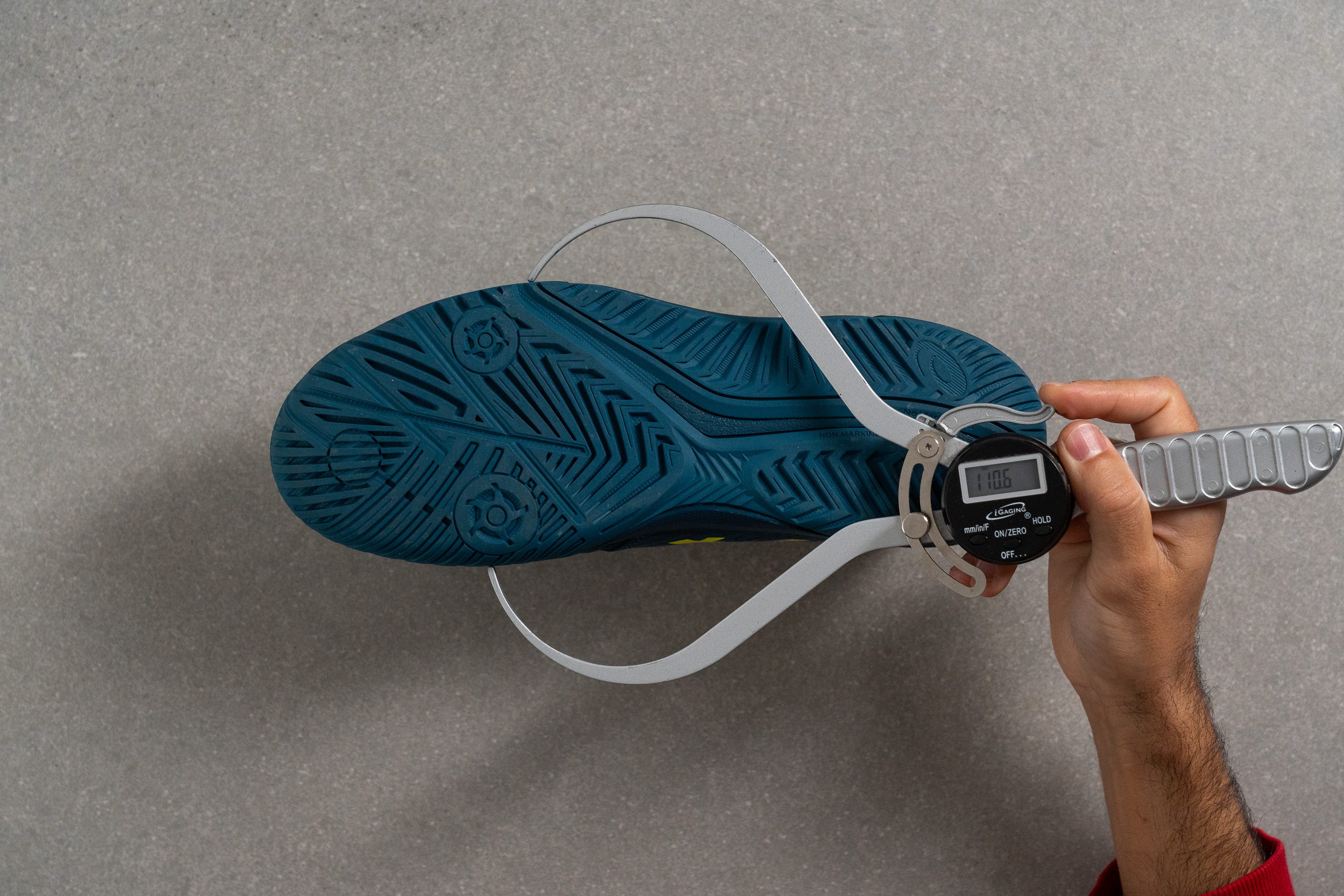
| Asics Gel Challenger 14 | 110.6 mm |
| Average | 111.9 mm |
Midsole width - heel
The same can be said about the shoe's heel width. The distance between its widest points here is 88.5 mm. Not among the widest on our roster for sure.
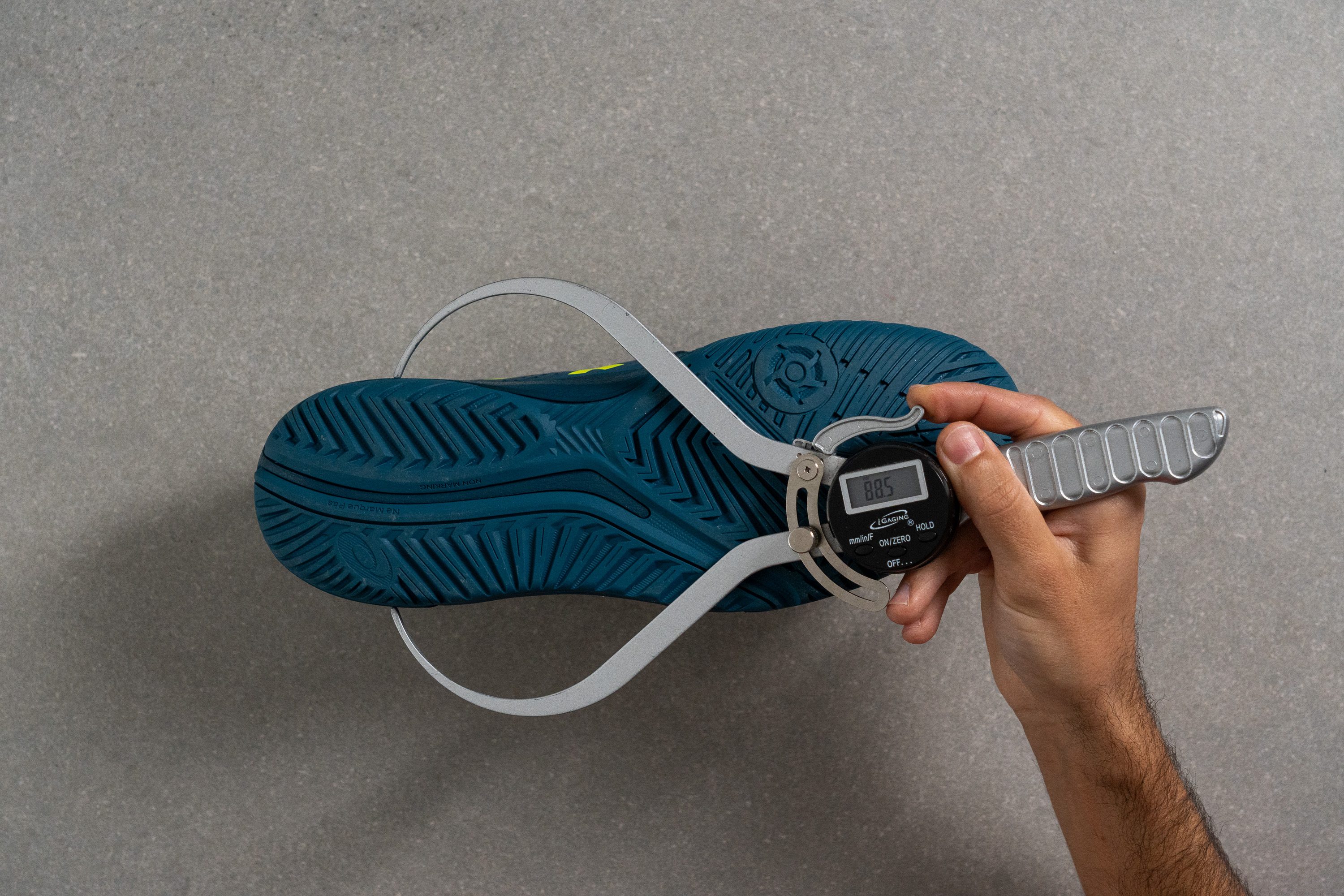
| Asics Gel Challenger 14 | 88.5 mm |
| Average | 89.6 mm |
Durability
Toebox durability
From the beginning, our hopes were set high for the Challenger 14's upper durability. With that dense synthetic layer it is supposed to be tough, right?
Well, as our Dremel test shows, not so much.
With the speed set to 5K RPM, we held the tool's sandpaper tip against the shoe's toebox for 12 seconds. And the result was far from encouraging.
The tool drilled right through the synthetic layer, damaging the lining beneath it too. For that reason, we couldn't rate the shoe's toebox durability higher than 3 out of 5.

While there is a toe drag guard on this ASICS shoe, it is not as substantial as in the brand's other models. Even though it offers protection, it won't help much when you happen to brush a non-guarded area of the upper against the court.
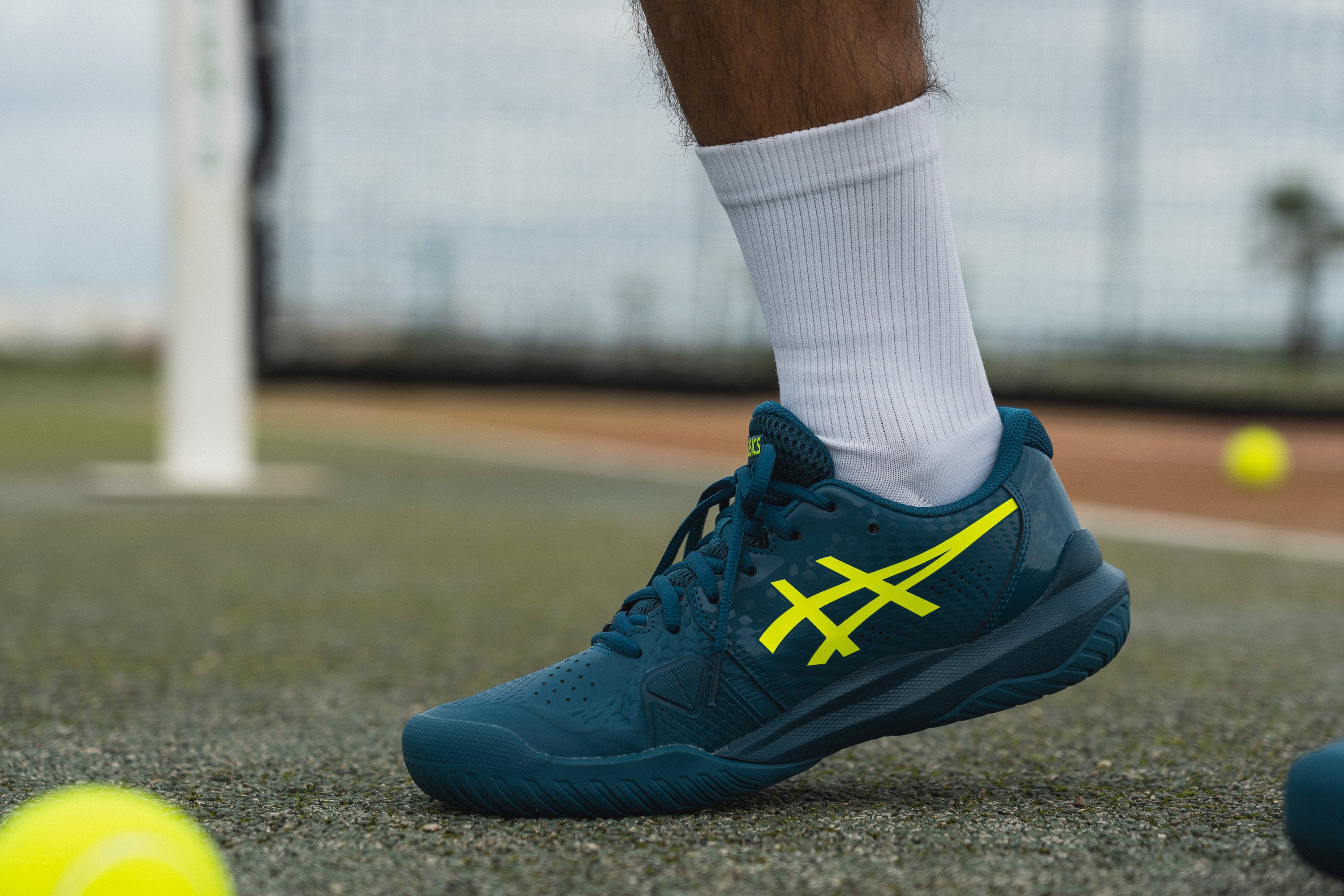
| Asics Gel Challenger 14 | 3 |
| Average | 3.7 |
Heel padding durability
Of course, we cannot expect stellar durability from a budget-friendly model. But we must also be open about the shoe's shortcomings.
The Challenger's heel collar padding was the next part touched by our demanding Dremel. The delicate mesh gave in rather quickly as it took a mere 4 seconds to tear it apart.
On a 1-5 scale, where 1 is the least abrasion-resistant, we gave it the lowest score.
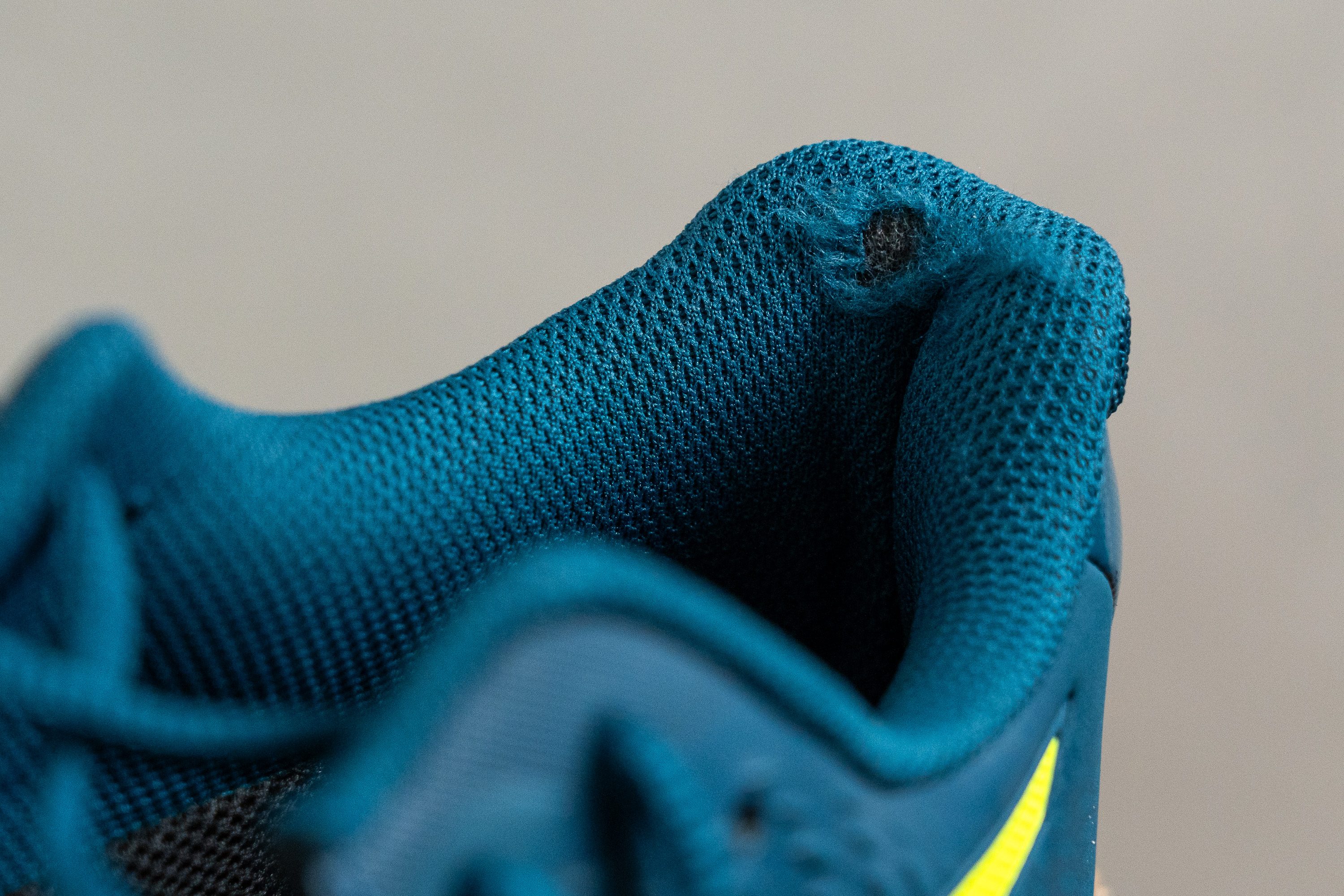
| Asics Gel Challenger 14 | 1 |
| Average | 3.3 |
Outsole hardness
Seeing the pitfalls of the upper, we were more cautious about the shoe's outsole durability. But luckily, it performed rather well in our lab tests.
First of all, its rubber compound is adequately hard, showing 86.5 HA on our durometer. This is just as hard as in the more expensive tennis shoes. Softer rubbers tend to wear out way faster on the hard court.
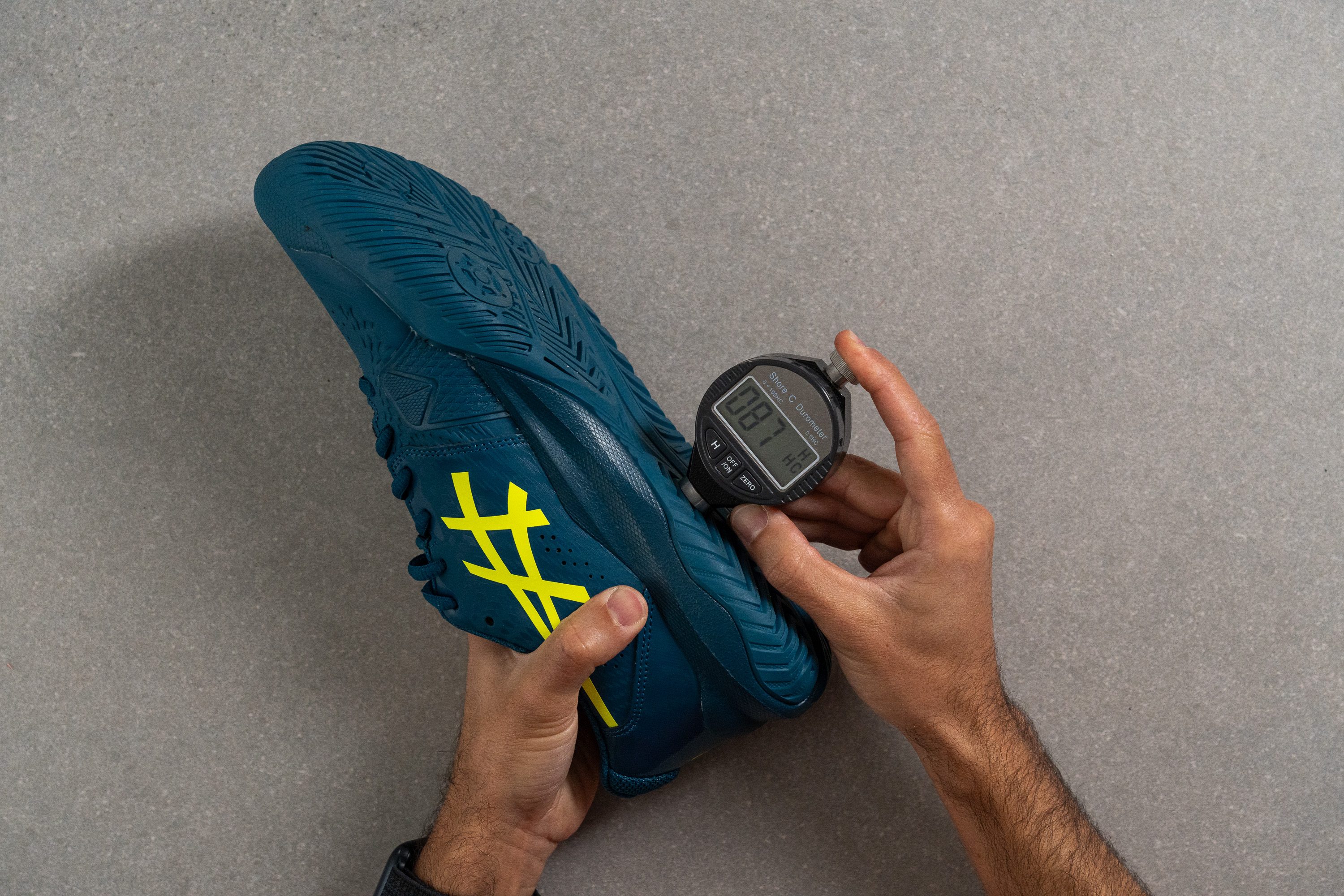
| Asics Gel Challenger 14 | 86.5 HC |
| Average | 86.0 HC |
Outsole durability
Going all out, we amped up the Dremel speed to 10K RPM and held its sandpaper tip against the shoe's outsole for 22 seconds.
The shoe's AHAR PLUS rubber held up fabulously, just like we would expect from ASICS' top-tier outsole. It seems as though the Dremel only brushed the dust off the shoe as our tread gauge showed a minuscule dent of 0.4 mm.
Smaller than average, it reassured us of the Challenger 14's shelf life.
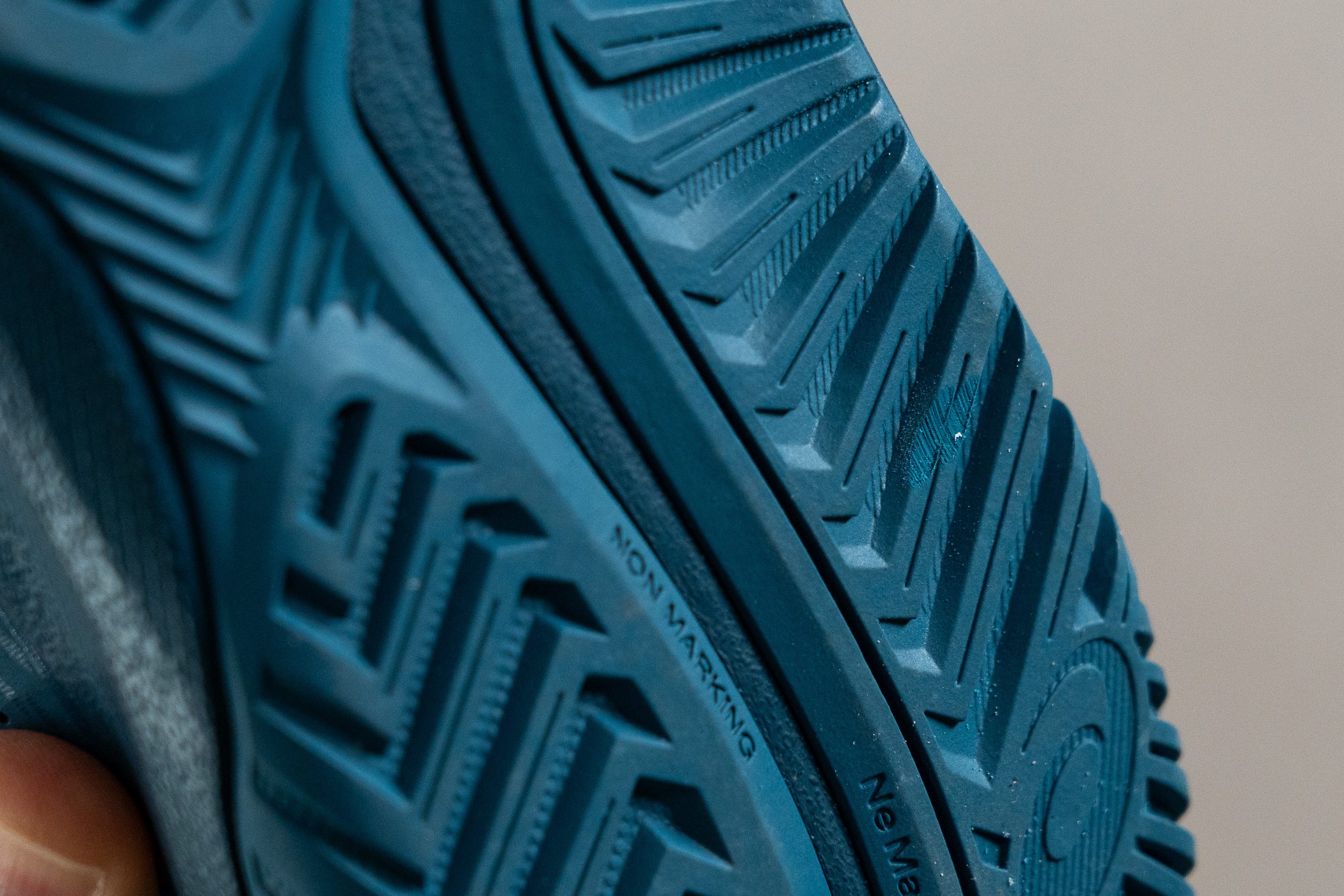
| Asics Gel Challenger 14 | 0.4 mm |
| Average | 0.8 mm |
Outsole thickness
Even though there is no durability warranty for this ASICS shoe, its resistance to abrasion and the amount of rubber look promising enough to us.
Based on our calliper measurements, the outsole of the Challenger is 4.1 mm thick. That's a solid slab of rubber to wear through!
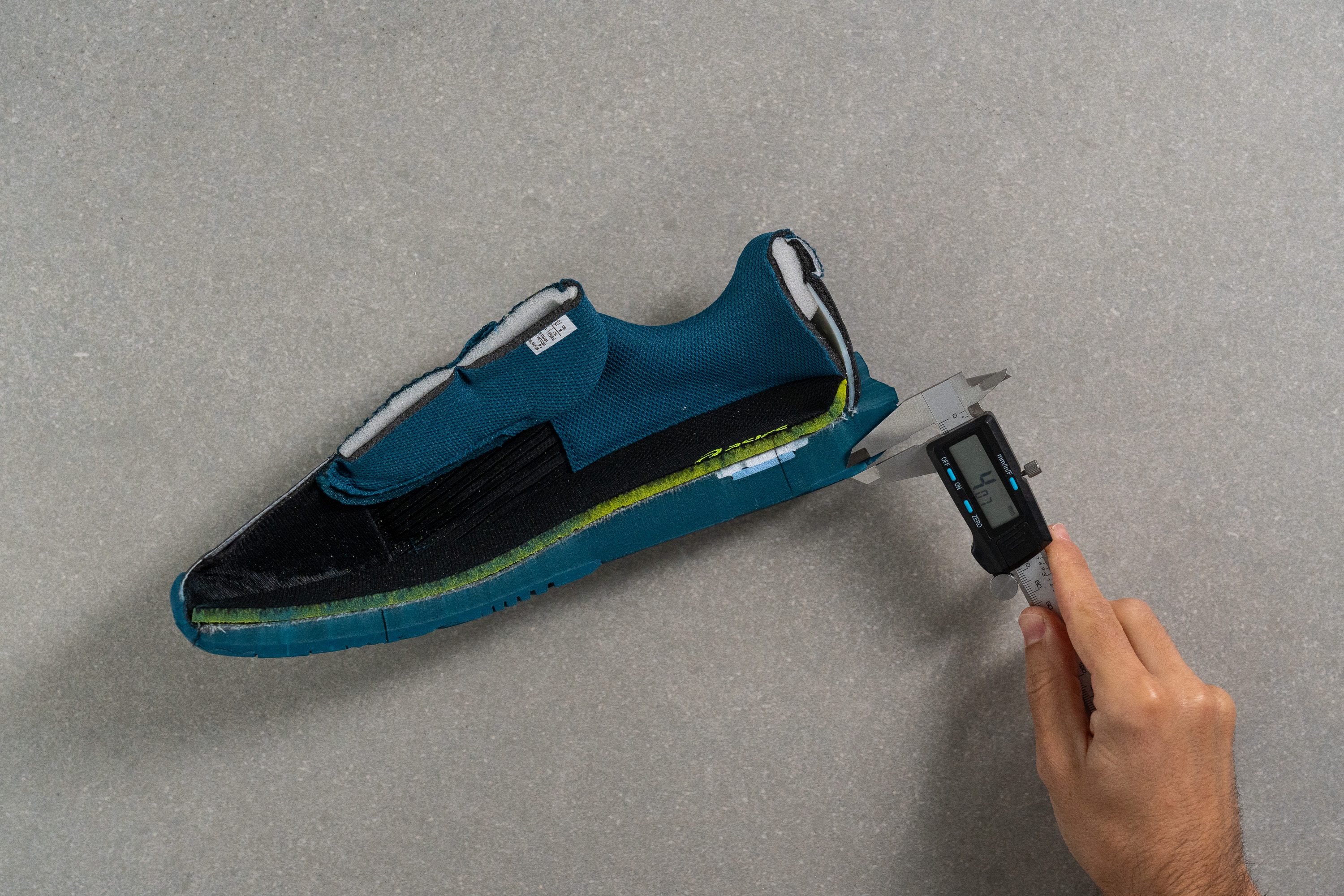
| Asics Gel Challenger 14 | 4.1 mm |
| Average | 4.2 mm |
Misc
Insole thickness
Finishing up the shoe's cushioning setup is a fairly well-padded insole. Based on our calliper, it is 5.2 mm thick which is standard for tennis footwear.
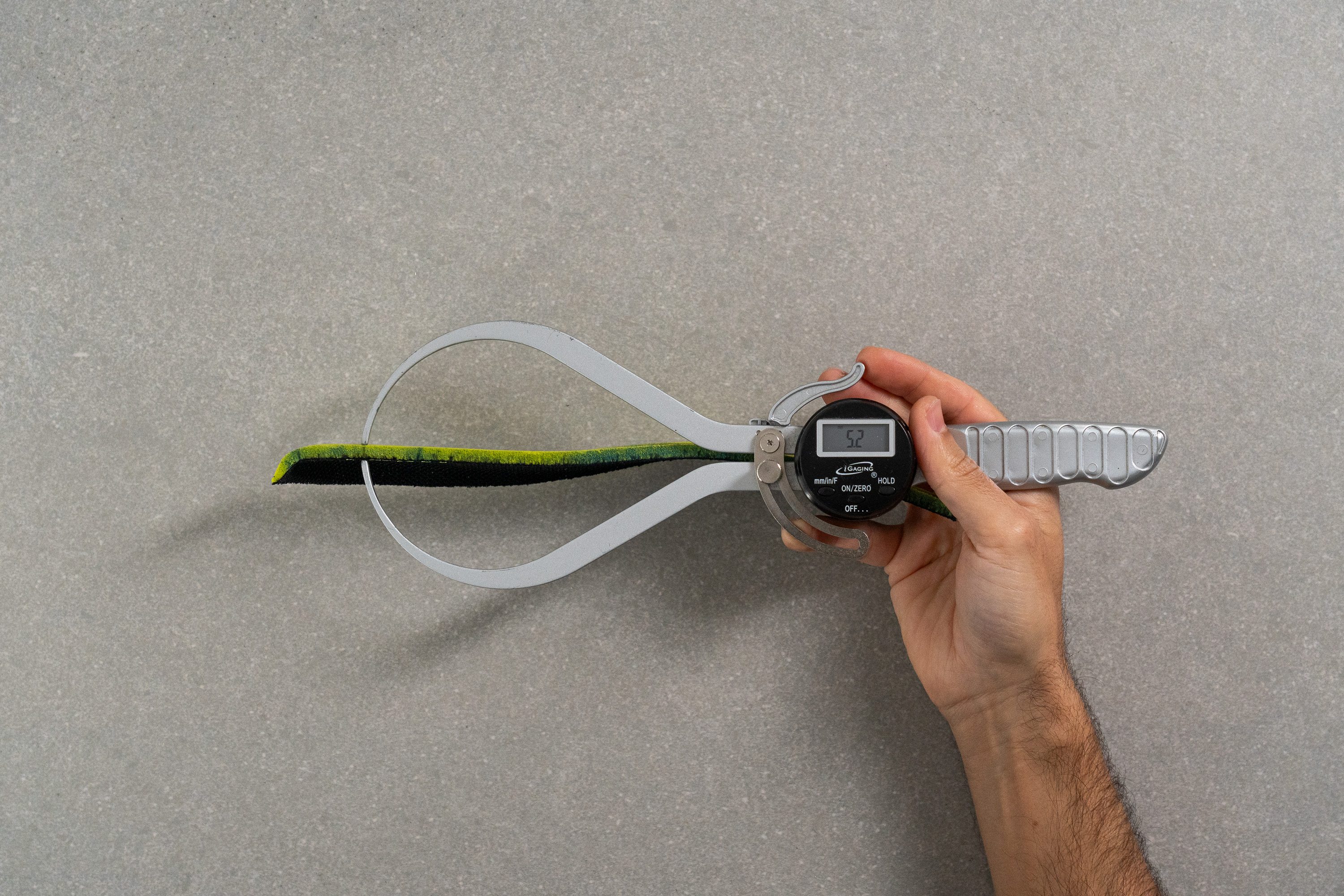
| Asics Gel Challenger 14 | 5.2 mm |
| Average | 5.1 mm |
Removable insole
If you happen to use custom orthotics or a different kind of insert, the shoe's stock insole is easily removable and can be swapped just like that.

| Asics Gel Challenger 14 | Yes |
Tongue padding
On the inside, this ASICS shoe is all about padding and comfort. It packs lots of foam around the collar as well as in the tongue.
The tongue in particular is 10.5 mm thick! That's notably thicker than average, by a few millimetres. So don't mind the £100 price tag - ASICS made sure that you get the cushiest experience inside the shoe.
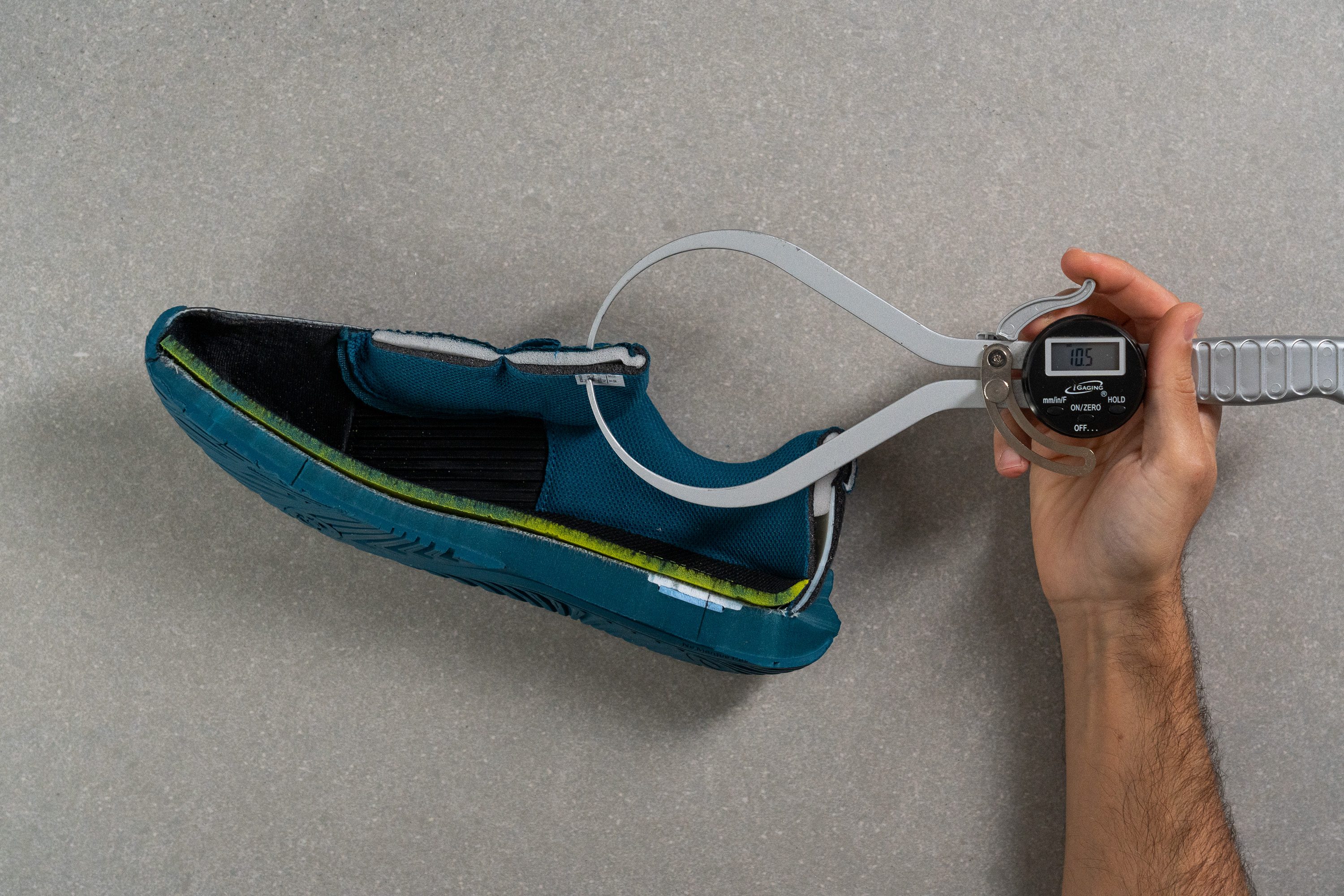
| Asics Gel Challenger 14 | 10.5 mm |
| Average | 8.1 mm |
Tongue: gusset type
Given its price point, the ASICS Challenger 14 is a simple shoe. It doesn't feature extra add-ons such as tongue gussets. So there is a small risk of tongue shifting in this model but nothing too critical.
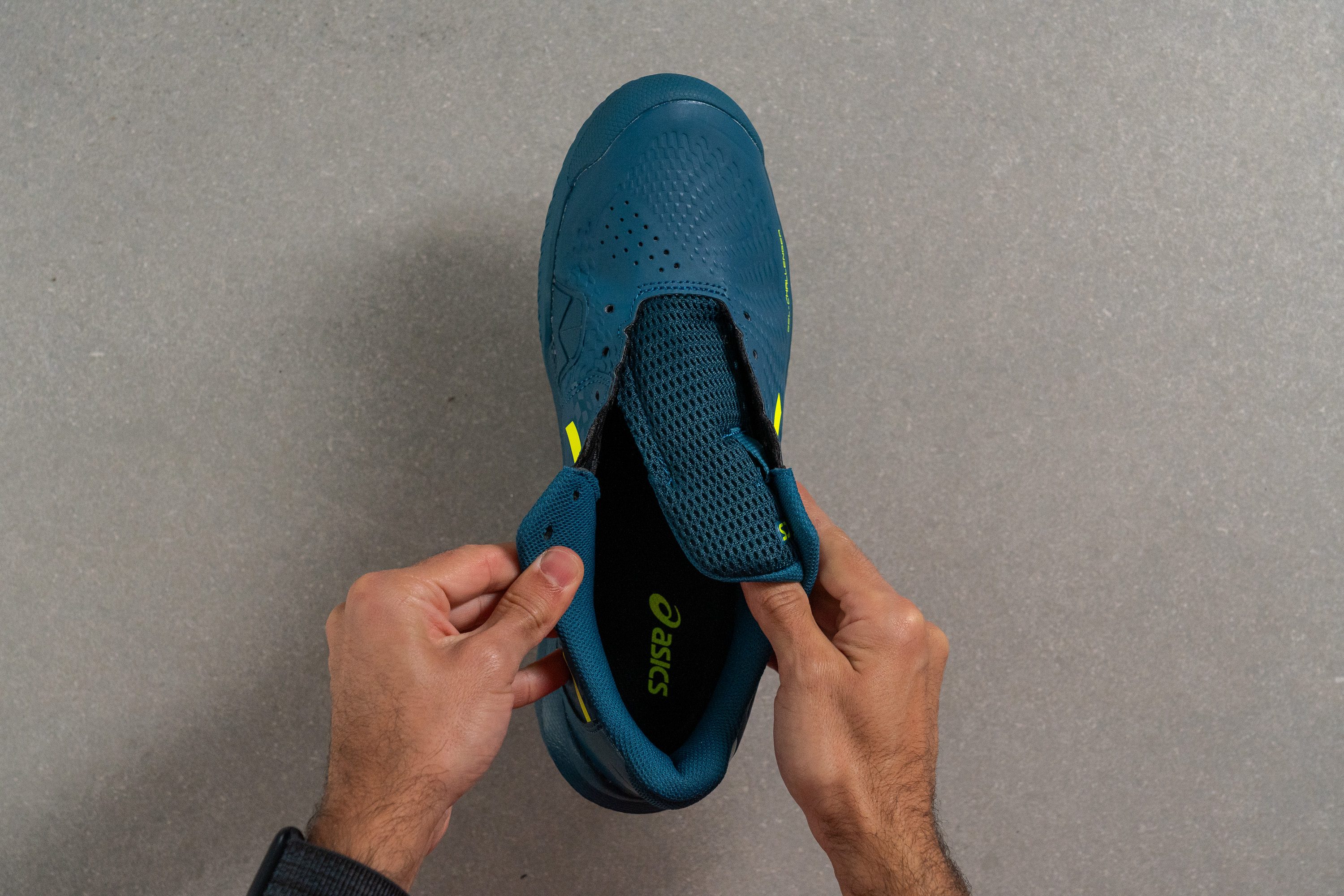
| Asics Gel Challenger 14 | None |
Heel tab
There are no heel tabs to hold onto when putting on the ASICS Gel Challenger 14. But the fact that its tongue is not gusseted really helps to keep the shoe's opening wide and slide into it quickly.

| Asics Gel Challenger 14 | None |

